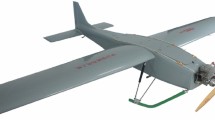Abstract
The problem of flapping motion control of Micro Air Vehicles (MAVs) with flapping wings was studied in this paper. Based upon the knowledge of skeletal and muscular components of hummingbird, a dynamic model for flapping wing was developed. A control scheme inspired by human memory and learning concept was constructed for wing motion control of MAVs. The salient feature of the proposed control lies in its capabilities to improve the control performance by learning from experience and observation on its current and past behaviors, without the need for system dynamic information. Furthermore, the overall control scheme has a fairly simple structure and demands little online computations, making it attractive for real-time implementation on MAVs. Both theoretical analysis and computer simulation confirms its effectiveness.
Similar content being viewed by others
References
Grasmeyer J M, Keennon M T. Development of the black widow micro air vehicle. The 39th AIAA Aerospace Sciences Meeting and Exhibit, Reston, VA, USA, 2001, AIAA-2001-0127.
Green W E, Oh P Y. A fixed-wing aircraft for hovering in caves, tunnels, and buildings. Proceedings of the 2006 American Control Conference, Minneapolis, Minnesota, USA, 2006, 1092–1097.
Pornsin-Sisirak T N, Lee S W, Nassef H, Grasmeyer J, Tai Y C, Ho C M, Keenon M. MEMS wing technology for a battery-powered ornithopter. Proceedings of the 13th Annual IEEE International Conference on Micro Electro Mechanical Systems, Miyazaki, Japan, 2000, 799–804.
Dickinson M H, Lehmann F, Sane S P. Wing rotation and the aerodynamic basis of insect flight. Science, 1999, 284, 1954–1960.
Dudley R. The Biomechanics of Insect Flight: Form, Function, Evolution, Princeton University Press, Princeton, NJ, USA, 2000.
Burton R. The World of the Hummingbird, Firefly Books, Ontario, Canada, 2001.
Nagai H, Isogai K, Fujimoto T, Hayase T. Experimental and numerical study of forward flight aerodynamics of insect flapping wing. AIAA Journal, 2009, 47, 730–742.
Singh B, Chopra I. Insect-based hover-capable flapping wings for micro air vehicles: Experiments and analysis. AIAA Journal, 2008, 46, 2115–2135.
Yan J, Wood R J, Avadhanula S, Sitti M, Fearing R S. Towards flapping wing control for a micromechanical flying insect. Proceedings of Robotics and Automation, Piscataway, NJ, USA, 2001, 3901–3908.
Deng X, Schenato L, Sastry S S. Flapping flight for biomimetic robotic insects. Part II: Flight control design. IEEE Transactions on Robotics, 2006, 22, 789–803.
Khan Z A, Agrawal S K. Control of longitudinal flight dynamics of a flapping-wing micro air vehicle using time-averaged model and differential flatness based controller. Proceedings of American Control Conference, New York, USA, 2007, 5284–5289.
Kluwe R H, Lüer G, Rösler F. Principles of Learning and Memory, Springer, Berlin, 2003.
Song Y D. Control of wind turbines using memory-based method. Journal of Wind Engineering and Industrial Aerodynamics, 2000, 85, 263–275.
Song Y D. Memory-based control of nonlinear dynamic systems. Part I: Design and analysis. IEEE International Conference on Industrial Electronics and Applications, Singapore, 2006, 1–6.
Weng L, Cai W, Zhang R, Song Y D. Bio-inspired control approach to multiple spacecraft formation flying. Proceedings of the IEEE Conference on e-Science and Grid Computing, Amsterdam, Netherlands, 2006, 120–126.
Raney D L, Slominski E C. Mechanization and control concepts for biologically inspired micro air vehicles. Journal of Aircraft, 2004, 41, 1257–1265.
Grant D T, Abdulrahim M, Lind R. Flight dynamics of a morphing aircraft utilizing independent multiple-joint wing sweep. AIAA Atmospheric Flight Mechanics Conference and Exhibit, Keystone, USA, 2006, AIAA-2006-6505.
Buler W, Loroch L, Sibilski K, Zyluk A. Modeling and simulation of the nonlinear dynamic behavior of a flapping wings micro-aerial-vehicle. The 42nd AIAA Aerospace Sciences Meeting and Exhibit, Reno, USA, 2004, AIAA-2004-0541.
de Croon G C H E, de Clerq K M E, Ruijsink R., Remes B, de Wagter C. Design, aerodynamics, and vision-based control of the DelFly. International Journal on Micro Air Vehicles, 2009, 1, 71–97.
Author information
Authors and Affiliations
Corresponding author
Rights and permissions
About this article
Cite this article
Song, Y.D., Weng, L. & Lebby, G. Human Memory/Learning Inspired Control Method for Flapping-Wing Micro Air Vehicles. J Bionic Eng 7, 127–133 (2010). https://doi.org/10.1016/S1672-6529(09)60201-8
Published:
Issue Date:
DOI: https://doi.org/10.1016/S1672-6529(09)60201-8




